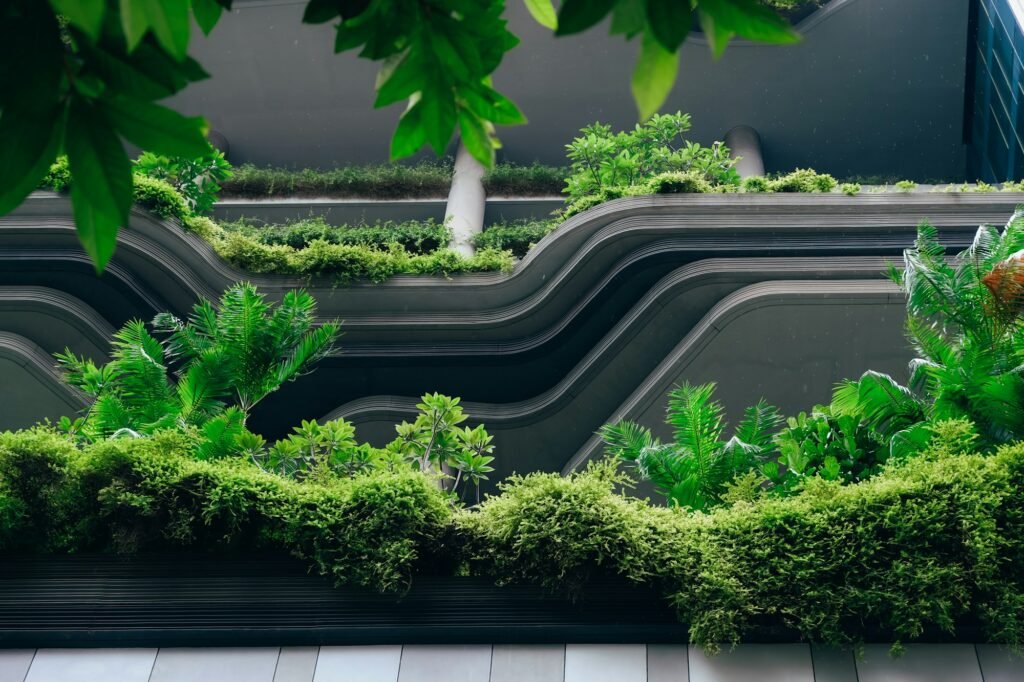Benefits of Biophilic Design for Life

What is Biophilic Design?
Biophilic design is an innovative approach that seeks to incorporate natural elements into built environments. Originating from the term “biophilia,” which refers to humans’ innate affinity for nature, biophilic design aims to bridge the gap between nature and modern architecture. This design philosophy rests on the belief that integrating natural elements such as greenery, water features, natural light, and organic materials can significantly enhance human well-being.
The core principles of biophilic design focus on creating spaces that mimic the natural world, thus fostering a sense of connection with the environment. Key elements include the use of natural materials, ample daylight, and the incorporation of plant life. By intertwining these elements within architectural structures, biophilic design promotes mental and physical health, reduces stress, and increases productivity.
Leaders in Design
This design approach has been gaining traction across various sectors. In residential spaces, biophilic design creates serene and nurturing environments that improve the quality of life for inhabitants. In commercial settings, it plays a crucial role in enhancing workplace satisfaction and efficiency. Educational institutions also benefit from biophilic design by providing students with stimulating and healthy learning environments. The applicability of this design philosophy is vast, making it an appealing choice for diverse projects.
The global recognition of biophilic design is on the rise as more people become aware of its benefits. Firms like DV8 Design are at the forefront of this movement, pioneering spaces that prioritize human health and wellness through a connection with nature. The increasing demand for such environments underscores a shift towards sustainable and human-centered design practices. By fostering a harmonious relationship between humans and the natural world, biophilic design not only enhances aesthetic appeal but also contributes to a holistic sense of well-being.
Innovative Concepts by DV8 Design and Serendipity by Design
DV8 Design and Serendipity by Design have established themselves as pioneers in the field of biophilic and ontological architecture. These firms are recognized for their unique approaches and innovative concepts, which seamlessly integrate natural elements into their designs. Their commitment to enhancing the quality of life for occupants sets them apart in the industry.
DV8 Design is known for its forward-thinking approach to biophilic design. By incorporating elements such as natural light, greenery, and organic materials, DV8 Design creates spaces that foster a connection between occupants and nature. One notable project is the Green Haven Office, where indoor gardens and expansive windows are used to blur the lines between indoor and outdoor environments. This design not only enhances aesthetic appeal but also promotes well-being and productivity among employees.
Serendipity by Design also excels in biophilic and ontological architecture but with a distinctive twist. Their projects often emphasize the philosophical aspects of space and human interaction. The firm’s innovative use of water features, natural textures, and eco-friendly materials contributes to an immersive sensory experience. A prime example is the Harmony Wellness Center, where the integration of natural elements creates a serene environment conducive to relaxation and mental clarity.
Both firms exemplify how biophilic and ontological design can transform conventional spaces into holistic environments. DV8 Design’s projects often incorporate sustainable practices, such as using reclaimed wood and energy-efficient systems, further demonstrating their commitment to environmental stewardship. Similarly, Serendipity by Design’s work is characterized by a deep understanding of how space influences human behavior and emotions, ensuring their designs are as functional as they are visually appealing.
In conclusion, DV8 Design and Serendipity by Design are at the forefront of biophilic and ontological architecture. Their innovative concepts and dedication to integrating natural elements into their designs not only create aesthetically pleasing spaces but also significantly enhance the quality of life for their occupants. Through their pioneering work, these firms are setting new standards in the industry, showcasing the profound impact that thoughtful, nature-inspired design can have on the built environment.
Health and Wellness Benefits of Biophilic Design
Biophilic design, a concept championed by leading firms such as DV8 Design and Serendipity by Design, emphasizes the integration of natural elements into built environments. This approach is grounded in the idea that humans have an innate connection to nature, a theory known as biophilia. An array of scientific studies and expert opinions support the benefits of biophilic design on health and wellness.
Natural Elements
Incorporating elements such as plants, natural light, water features, and natural materials into living and working spaces has been shown to significantly reduce stress levels. A study published in the Journal of Environmental Psychology found that exposure to natural environments can lower cortisol levels, a key indicator of stress. Additionally, access to natural light is not only beneficial for regulating circadian rhythms but also enhances mood and cognitive function. Research by the American Psychological Association has demonstrated that individuals working in environments with ample natural light exhibit higher productivity and job satisfaction.
Moreover, the presence of plants and greenery within indoor spaces contributes to improved air quality, which can lead to better respiratory health. A study by NASA revealed that certain houseplants can remove up to 87% of air toxins in 24 hours. This is particularly significant in urban settings where air quality can be compromised. Water features, such as fountains or aquariums, introduce a sense of tranquility and have been found to lower blood pressure and heart rate, further promoting a sense of well-being.
Human Experience
Biophilic design also supports mental health by creating environments that encourage relaxation and reduce anxiety. According to the International Journal of Environmental Research and Public Health, natural elements in indoor spaces can reduce symptoms of depression and enhance overall emotional well-being. The interplay of natural materials like wood and stone fosters a tactile connection to nature, which can be soothing and grounding.
By integrating these natural elements, biophilic design can transform living and working environments into healthier and more inviting spaces. This holistic approach not only nurtures physical health but also significantly enhances mental and emotional well-being, creating a balanced and harmonious environment conducive to overall human flourishing.
Future Trends in Biophilic Design
The future of biophilic design is poised for significant advancements, driven by the innovative approaches of leading firms such as DV8 Design and Serendipity by Design. As urbanization continues to escalate globally, the demand for sustainable and health-promoting environments has never been more critical. In addressing this need, DV8 Design and Serendipity by Design are at the forefront of integrating emerging technologies and materials into their biophilic design principles.
One prominent trend is the incorporation of smart technology to create adaptable environments that respond to the presence and needs of occupants. From intelligent lighting systems that mimic natural daylight cycles to advanced climate control systems that enhance indoor air quality, these technologies are shaping the future of ontological architecture. By seamlessly blending nature with technology, firms like DV8 Design are pioneering spaces that not only enhance aesthetic appeal but also promote physical and mental well-being.
Materials innovation is another significant area of focus. Sustainable materials, such as reclaimed wood, recycled metals, and biocomposites, are becoming increasingly popular. These materials not only reduce environmental impact but also contribute to the aesthetic and tactile qualities of biophilic design. Serendipity by Design, for instance, is exploring the use of living walls and green roofs, which not only add a visual connection to nature but also improve insulation and reduce urban heat island effects.
Sustainable practices are integral to the ethos of biophilic design. Both DV8 Design and Serendipity by Design are committed to reducing their carbon footprint through energy-efficient building practices and the use of renewable energy sources. This alignment with sustainability goals not only underscores the environmental benefits of biophilic design but also its economic viability and long-term value.
Final Thoughts
As cities continue to grow and the need for sustainable development intensifies, the role of biophilic design becomes increasingly pivotal. By fostering a deeper connection to nature within urban spaces, firms like DV8 Design and Serendipity by Design are not only enhancing the quality of life for individuals but also contributing to the broader goal of creating resilient and sustainable communities.
References
Soderlund, J., & Newman, P. (2015). Biophilic architecture: a review of the rationale and outcomes. AIMS environmental science, 2(4), 950-969.
Serependity by Design (https://serendipity.ae)
DV8 Design (https://dv8design.ae)
Joye, Y. (2007). Architectural lessons from environmental psychology: The case of biophilic architecture. Review of general psychology, 11(4), 305-328.









